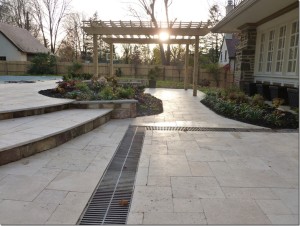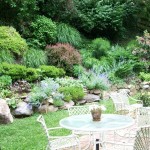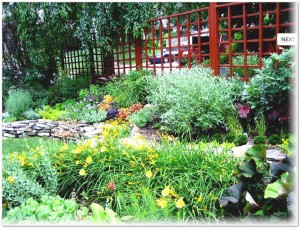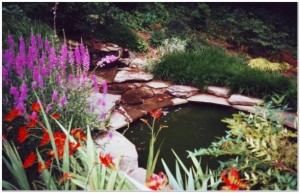
Main Line Landscaping Design Featuring a Rock Garden – Image via Aardweg Landscaping, Newtown Square, PA
Planning to incorporate a rock garden in your next landscaping design? Rock gardens offer solutions to landscaping problems, and also add visual interest in the yard. When considering how you can use attractive and interesting rocks in your Main Line residential landscaping design, remember that natural stone is one of the most versatile elements available for a landscaped garden. Adding varying textures and contrasting materials to the flora, rocks provide stability and durability in the landscaped garden, and require little or no maintenance.
Rock Gardens Solve Functional Problems
Many a homeowner or landscape designer when confronted with a rocky, sloping property will wisely consider including a rock garden in the final landscape solution. Using the terrain’s rockiness advantageously and featuring assorted sizes of color-coordinated stone will add the texture and interest needed to create a striking garden.
Rock Gardens Suit Small and Large Garden Areas
One of the primary factors that influences the layout and design of a rock garden is the available space. If the space is restricted and small, although relatively flat, you can design a raised bed made of carefully selected rocks. This rock garden design won’t be in the way during yard and garden maintenance, nor will it require much upkeep. With a large area, the design objective is to create sprawling, naturalistic combinations of plant and stone focal areas.
Color Coordinated Rocks for the Garden
A careful selection of color-coordinated rocks will form the basic structure for the rock garden. The popular raised bed rock garden typically sits at some elevation above the surrounding ground in the Main Line garden, which requires laying a first course of color coordinated rocks and soil. The color grouping will also affect the plant selection.
Best Plant Selection for the Rock Garden
Rock gardens are most frequently found in informal cottage garden styles that have a less formal, asymmetrical and organic design. While it is often preferred to select plants based on color and growth requirements, rock-garden plants require good drainage, prefer a sunny area and provide variation in height and texture. The designer arranges the plants in a rock garden design to look natural. Avoid symmetry in the garden, as it looks unnatural in rock garden landscape design.
Some homeowners design rock gardens to exploit rocky slopes in their yards. Others import rocks into yards that are flat and rock-free. It is a demanding and strenuous operation, but the final product is well worth the effort. To learn more about how to incorporate a beautiful rock garden into your next landscape design or outdoor living area, schedule a complimentary on-site consultation with Aardweg Landscaping by calling 610.355.0703; or send an email using the website contact form.
 Aardweg Landscaping is a double Houzz award recipient. In 2015 Aardweg Landscaping of Newtown Square, PA received both
Aardweg Landscaping is a double Houzz award recipient. In 2015 Aardweg Landscaping of Newtown Square, PA received both  the “Best Of Houzz” 2015 award for Customer Satisfaction by Houzz, and the exclusive “Recommended” badge for top rated professionals on Houzz.
the “Best Of Houzz” 2015 award for Customer Satisfaction by Houzz, and the exclusive “Recommended” badge for top rated professionals on Houzz.



